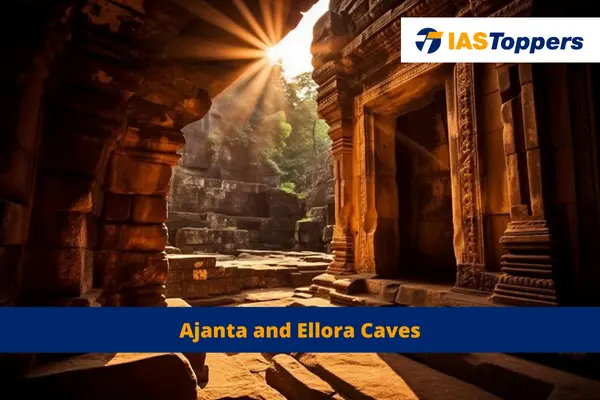The Ajanta and Ellora caves are two of India’s most famous rock-cut cave complexes, located in the Aurangabad district of Maharashtra. They are famous for temple architecture, murals and sculptures, monasteries etc. These UNESCO World Heritage Sites are known for their ancient rock-cut architecture, religious tolerance, and artistic traditions.
Ajanta and Ellora Caves will be helpful for UPSC IAS Exam preparation. GS Paper-1 Art and Culture.
Ajanta and Ellora caves
The difference between Ajanta Caves and Ellora Caves is given below:
| Ajanta Caves | Ellora Caves |
| Located in Aurangabad District, Maharashtra, India. | Located in northwest-central Maharashtra state, western India. |
| – Consists of 29 rock-cut Buddhist cave monuments. | Consists of 34 magnificent rock-cut temples. |
| 25 caves used as Viharas, 4 as Chaitya or prayer halls. | 17 caves are Hindu, 12 are Buddhist, and 5 are Jain. |
| Constructed from the second century BCE to about 480 CE. | Constructed after the Ajanta Caves. |
| Famous for temple architecture, delicately drawn murals and sculptures. | Served as monasteries and temples, some include sleeping cells for monks. |
| Mentioned in memoirs of Chinese Buddhist travellers from the medieval era. | Patronized by Rashtrakutas, Kalachuris, Chalukyas, and Yadavas. |
| UNESCO World Heritage Site | UNESCO World Heritage Site |
Ajanta and Ellora Cave Paintings
Ajanta Cave Paintings:
- Ajanta cave has one of the oldest surviving murals of the Indian sub-continent.
- These Buddhist caves are quite popular for their exquisite mural paintings.
- The paintings at Ajanta are a combination of murals and frescoes.
- The murals are painted on dry plaster, while the frescoes are painted on wet plaster.
- The paintings are done in the tempera style, which is a technique that uses pigments mixed with egg yolk.
- Subject Matter: Jataka stories, the life of the Buddha, elaborate decorative patterns of flora and fauna, and graceful poses of humans and animals.
- Features: unique hairstyle of the female figure, emotions in animals and birds, red ochre outline etc
- Important paintings of Ajanta: Jataka Stories, Bodhisattvas, Dying Princess, Shibi Jataka, Matri-Poshaka Jataka, and Temptation of Mara.
Ellora Cave Paintings:
- The mural paintings at Ellora are found in five caves, mostly limited to Cave No. 16, i.e., Kailasha Temple.
- Phases: first phase paintings were done during the carving of the caves, while second phase ones were done several centuries later.
- The paintings are related to Buddhism, Hinduism, and Jainism.
- Ellora Cave paintings are newer as compared to Ajanta Cave paintings.
- Important paintings of Ellora: Goddess Lakshmi and Lord Vishnu, Lord Shiva with his followers, and Beautiful and gracious Apsaras.
Conclusion
Ajanta and Ellora caves are impressive and both have distinct differences. The Ajanta Caves consist of 29 rock-cut Buddhist cave monuments, while the Ellora Caves consist of 34 magnificent rock-cut temples, including 17 Hindu, 12 Buddhist, and 5 Jain caves. The Ajanta Caves were constructed from the second century BCE to about 480 CE, while the Ellora Caves were constructed after the Ajanta Caves. The Ajanta Caves are famous for their delicately drawn murals, while the Ellora Caves are known for their temple architecture and sculptures, especially the Kailashnath Temple.
Ref:Source-1
| Other Articles in History & Culture | |
| Pala Dynasty | Jainism in India |
| Miniature Painting | Aryabhatta |
| Pandya Dynasty | Modern Indian Painting |
FAQs (Frequently Asked Questions)
Where are Ajanta and Ellora caves Situated?
Ajanta and Ellora caves are situated in Maharashtra State, India.
What is the distance between Ajanta caves and Ellora caves?
Ajanta and Ellora caves are about 100 km away from each other.
Who built Ajanta and Ellora caves?
Ajanta caves are built in the Gupta Period. Ellora Caves were built during the Rashtrakuta dynasty.


